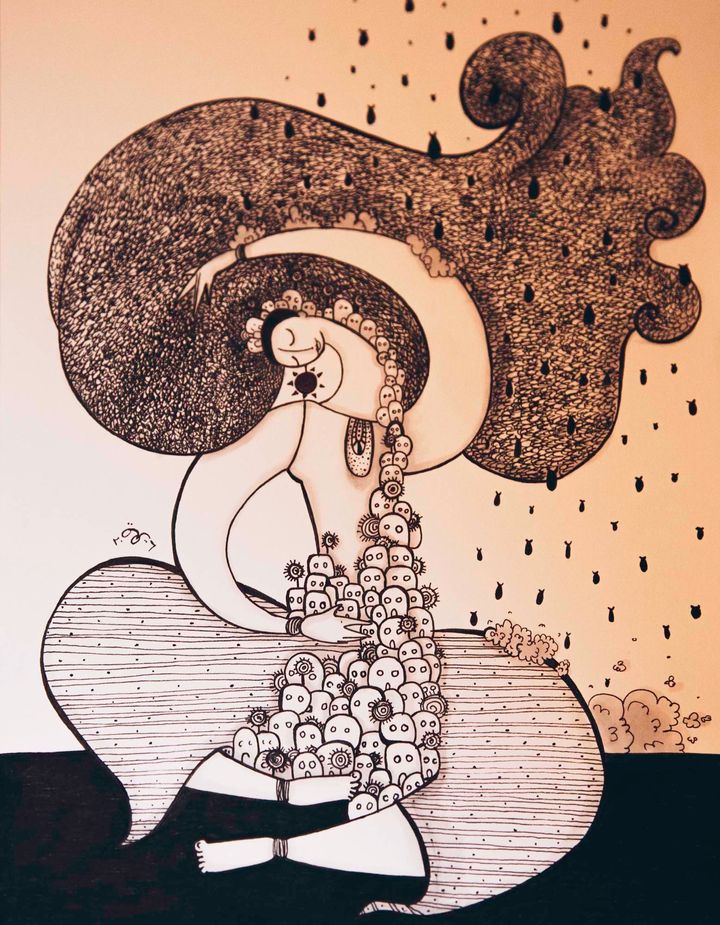
It’s 10am in the morning. I am looking at the image of a woman being helped at the shore in a boat that’s filled with refugees.
She looks terribly distressed, collapsing and almost broken down.
I am sipping my morning coffee while still looking at the image.
I move away to do something else and life goes on.
A Confession to Make
I have been angry for while now. Angry that images of war in my country Yemen and elsewhere evoke nothing but numbness. I no longer follow the news, and I’m not much moved by photographs of war. Do I care less? I don’t think so. I am simply emotionally exhausted and I have reached the point where I surrendered myself to it. The writer Susan Sontag succinctly articulated this phenomenon when she said that some photographs might deaden our emotions and promote emotional detachment. Our emotions travel through a cycle where these photographs excite and upset us, then finally exhaust us so that we become immune to their enticement. On behalf of the photographer in me, I apologize. But I have no option but to agree with this less ambitious claim about photographs. I have always believed photography is one of the most important things invented in human history. It allows – or forces – us to pay attention, reflect and examine the rationalization for mass suffering caused by those who entertain themselves by causing endless pain. Perhaps, photography isn’t magical after all and it’s less expressive than other art forms. For this reason, later in this piece I will introduce you to a Syrian artist and illustrator, Dima, who shines a light on the struggle in her country in a beautiful way, one that can hardly make you numb.
I know you are quite disappointed? Aren’t you? Many photographers leave their homes, their families, and any semblance of normality to put their lives at risk for pictures that we are incapable of reacting to. Images of mass suffering flood our lives on a daily basis, but we unwillingly feel paralyzed to act upon them. We switch off the TV, we deactivate our Facebook accounts, and we turn off the radio. We disappear and choose to shield our senses from the senseless violence. Have you ever felt that these painful photographs speak to you? Something like a person in a boat would say, “why me, not you? Why are you in your bed now, looking at me while I’m soaking wet and dying?”
So what can we do? Is there a cure for our numbed response to images? A question I have been wondering about quite often is, why do we respond to a lifetime of suffering with a thought along the lines of: oh thank God we aren’t there? Sometimes I wish people could see the misery and the pain themselves. If only they could see what families look like under the rubble. Why would we expect people to react to something that they could never relate to? Why do we exhaust their emotions at all? Am I wrong?
In searching for a beautiful escape, I found Dima. A Syrian artist who sets an example of devoting herself to provide inspirational and surrealist stories of what may be considered to be ugly into something we can safely look at – A work that will generate questions and mixed feelings of sorrow for a sense of importance that we failed to cure. I am not underestimating the power of photographs, but I am giving you the chance to have your feelings amplified rather than numbed. I’m giving you the chance to experience empathy.

With violence and aggression continuing in Syria, horrible stories and images continue to come out of the country. Artists using all different types of mediums and from all kinds of backgrounds have tackled the crisis. Writers, musicians, and performers continue to speak about their homeland. The tools do not matter, all that matters is that they inform the world on what is happening through storytelling.
In 2013 Dima moved to Lebanon after violence escalated in her country and threatened her life, as it did for many others in Syria. She moved to Beirut not only to seek a new shelter, but rather to continue expressing herself and doing what she does best: illustrations of Syria and her dream of peace. Perhaps more than any other conflict in the 21st century, the Syrian conflict has been heavily photographed and documented in parallel with the rapidly growing use of social media. Dima used her talent and through illustrative art she drew the essence of brutality and barbarism in her country. She chose to speak for herself, to tell the narrative of hope and aggression, and to contribute to the living memory of Syria today. Dima started her journey toward becoming an artist when she was a child playing under the white jasmines peeking out from balconies in Damascus.
“Art, for me, is a journey,” Dima explained. “It was just a hobby. I drew when I was lonely, when I was happy, when I’m heart broken. It started with me expressing myself.”
This journey of self-expression was no longer relevant to Dima’s work when the conflict erupted in Syria. She began to confront threats surrounding her with an active engagement in making art for her country. Through a pen or pencil and a piece of paper Dima works to preserve the stories of Syrians, the humans that we don’t hear about in the news.
“My work is a contribution to the creation of my culture’s memories. It is about preserving and transmitting the stories of those humans who are treated as numbers in the media; those who die and suffer due to no fault of their own. I translate them into illustration narratives. I make sketches, based on recordings, testimonies, and texts” In nostalgic voice she continued “My characters are real, they are not fictional. These people are ordinary; all I do is present them in a fictional style. I want to be gentle. There is enough violence in the world; I don’t want to be harsh in how I deliver my stories.”

As I flipped through Dima’s work, I was amazed to hear about the characters in her artworks. They were either people detained by the regime, or people who died crossing the sea, or people who worked for peace and fought the aggression. Though Dima’s work provide scenes of the tragic events that happen in Syria, interestingly it pushes us to look more deep in it, not away. Dima’s compulsive intention in making this artwork stems from her belief that this would allow people to reclaim self-agency, and not only show a different perspective about Syria, but it will be a guide for the next generation to curry on the hard work.
“ I think of my project is as long term plan, I consider it to be part of the reconciliation process, something people will learn from. This is important for the next generation, so they don’t feel ashamed of what happened. They must be proud of the people who tried to make a change and see peace and follow their path”
Another thing triggered my attention to Dima’s work were the little houses that you could notice in all her work, particularly in a piece of work that she named “ I wish I could”
“I wish I could is my piece about Aleppo, it’s about me trying to contain the city and wishing to prevent the shelling from storming innocent people”

Perhaps Dima has failed to save Aleppo from the shelling, but she was able to create a work that would rescue our memories from forgetting what was happening in Syria. Something that we would share with empathy of delivering the story to a wider audience and not feeling numbed about it.
Dima’s last words to me and before I leave reminded me of Barbie Zelizer, the author of About To Die: How News Images Move the Public, who said “If a news image works, it doesn’t disappear when we cast aside the newspaper, dim the TV or turn off the Internet. That may be more intrusion than most people are willing to allow” I realize that Dima understand that images don’t work as they tend to disappear, and hence, she choose to engage in something that would stick in our memories. Something that you and I would feel safe to look at, hang in our living room and reserve it for ever.
For more art work by Dima, follow her account on Instagram @dimanashawi

